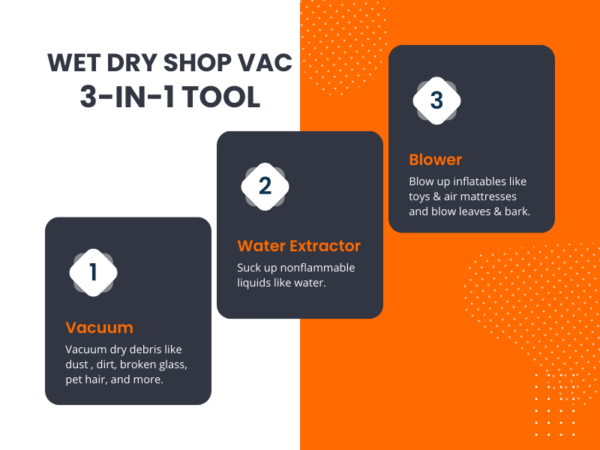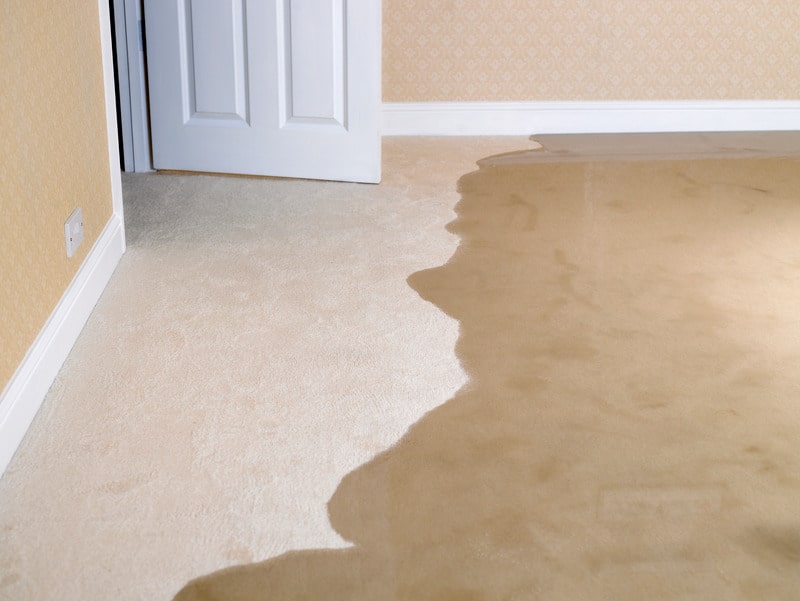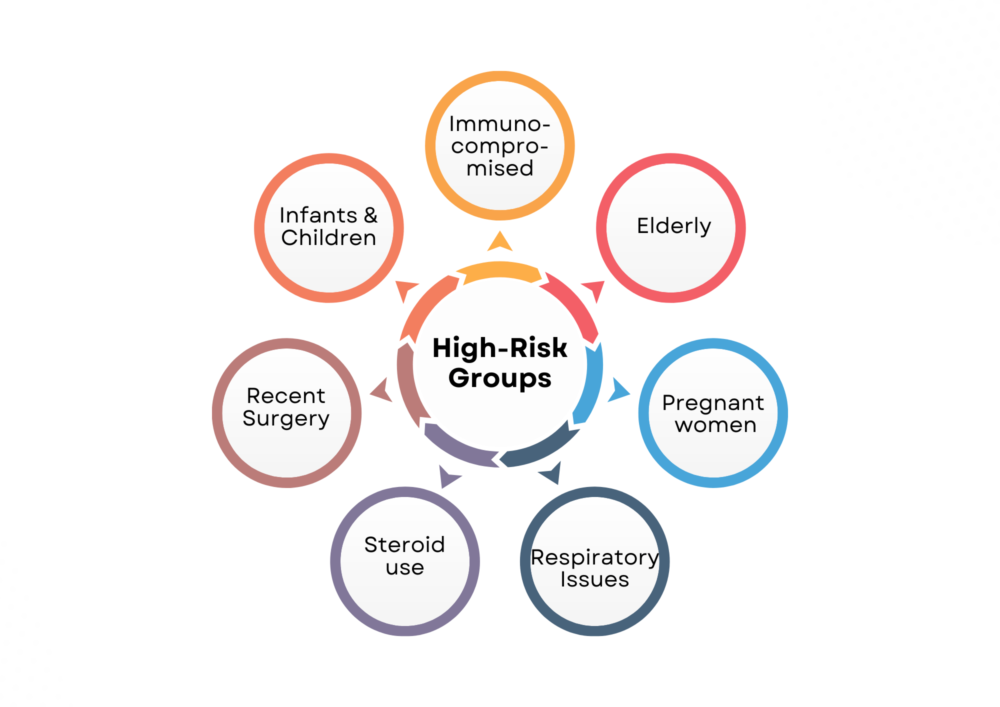Why a wet dry shop vac is the #1 tool to use to avoid mold.
Just as every structure should be equipped with a fire extinguisher, so should it be outfitted with a wet dry shop vacuum. The mere act of having a wet dry vac within arm’s reach could save a building owner thousands if not tens of thousands of dollars’ worth of water damage to their business or home should a leak or water intrusion event occur.
Mold will grow on wet building materials within 24-48 hours if not dried out. – Doug Hoffman, director, NORMI
What is a wet dry vac?
A wet dry vacuum cleaner can be used to suck up liquids like water from leaks and overflows as well as solid materials like dust, dirt, broken glass, and other debris. They are versatile machines that are oftentimes more rugged and powerful than a traditional household vacuum. Some wet dry vacuums are shop vacs, which have the added design feature to not only suck air but also blow air by reversing the airflow by connecting the hose to the exhaust port instead of the entry port. When set up as a blower, the shop vac can be used as a leaf blower, cleaning debris in hard-to-reach places, air pump for toys and air mattresses, and more.

How does a wet vac work?
Before using a wet dry vac to suck up water, make sure the dust/water container is empty. Connect the hose to the exhaust port, add the water attachments to the wand, turn on the unit, and then start sucking up the water. When done, empty the water from the bin and clean the filter according to the manufacturer’s instructions. It is important to realize that mold can grow on the filter and inside the wet vac, so do not close up the bin or use it as a dry vacuum until it is fully dry.
Be aware, even though a wet dry vac is designed to suck up water, it is not an amphibious vacuum. Only the wand and floor attachment should touch any source of water. The cord and body of the vacuum itself must remain dry and sit on dry ground.
The race against the clock
Speed is critical when dealing with water intrusion or a leak inside a structure because once building materials become wet, the clock starts ticking. It takes only 24 to 48 hours for mold growth to start. It doesn’t matter if it’s water from a broken pipe, a leaky dishwasher, or an overflowing washing machine, by having a wet dry vac already on hand, structural damage can be minimized or avoided altogether.

Preserving health
The similarities between a fire extinguisher and a wet dry vac don’t stop at protecting the dwelling; both also can be used to protect the occupants from life-threatening harm. Just as the fire extinguisher has the capacity to save lives, the wet dry vac has the ability to preserve the health of occupants when quickly and properly used to remove and reduce water damage.
In addition to removing as much water as possible with a wet dry vacuum, non-salvageable items and porous building materials like sheetrock must be removed from the structure. To accelerate the drying process to reduce the likelihood of structural mold forming, use fans to circulate air and dehumidifiers to reduce moisture in the air. The health effects of exposure to wet buildings, mold, and mycotoxins can be devastating to health, especially to people in high-risk groups. Wet building materials are also breeding grounds for bacteria and the associated bacterial toxins as well as volatile organic compounds (VOCs).
Water damage can be a silent killer
In the case of a fire, the risk to life is announced with the bells and whistles of fire alarms and suffocating smoke that can immediately take the breath away. Fire and smoke get people’s attention and fast! But when it comes to the risk to health from being in the presence of water-damaged building materials, no sirens alert the occupants of the potentially life-threatening danger. But know, nonetheless, that risk to the health of the occupants exists when building materials become wet and leads to mold growth causing mold and bacteria to condense in the indoor environment.
High-risk groups
People in mold high-risk groups are at increased risk when exposed to wet buildings and mold in indoor environments. It is important to understand that when mold is disturbed in an indoor environment, e.g., trying to clean or remove the mold, it leads to increased levels of mold and bacteria spores and fragments and respective toxins in the indoor air.
Individuals in one of these high-risk groups or people who have a family member in one of these groups should discuss the potential health risks associated with living or working in a water-damaged, moldy building.

Stop the water leak or intrusion!
No matter the size of the water leak or intrusion, the immediate goal is to locate the source of the water and address the cause, be it from a broken pipe or a roof leak so the flow of water is stopped. The second priority is to dry out the building materials within 24-48 hours to avoid mold growth.
According to Doug Hoffman, executive director of the National Organization of Remediators and Microbial Inspectors (NORMI), the first step in the drying out process is to always remove any standing water, which can be accomplished with a wet dry vac when the amount of water involved is small to medium in quantity. In cases of large amounts of water, such as with flooding, a pump will be required.
Once water has been removed, take the following three steps to expedite the drying process if the power is working:
- Turn up the heat.
- Get air moving with fans.
- Reduce airborne moisture with dehumidifiers.
How to remove drywall mold
All too often, water leaks are subtle and insidious, growing gradually in size in areas not immediately visible in the day-to-day life of the occupant. By the time the problem becomes apparent, the area of water damage can be sizeable and already be supporting a plantation of fungus, bacteria, and more. In this case, a HEPA wet dry vacuum or a HEPA wet dry shop vac is still your go-to tool.
Not only can you use your wet dry vac to remove the standing water, but you can also use it to vacuum up any mold growing on surfaces, according to Jim Pearson, CMH, past chairman of the Consensus Body over the publication of the two foremost industry standards on mold remediation: the IICRC S520 Standard for Professional Mold Remediation and the R520 Reference Guide for Professional Mold Remediation.
Furthermore, there is no need to wait for the mold or substrate to dry out because with a wet vac, the wet mold can be sucked up and contained into the wet dry vacuum’s sealed bin, without having to put yourself at risk from touching the mold or risk dispersing it into the indoor air you are breathing. Wearing personal protection equipment is still recommended.
When using a wet dry vac in the wet mode to clean mold off building materials, first line the water tank with an extra strength garbage bag to make disposal of the fungal debris simple and sanitary, suggests Mr. Hoffman.
In addition, once use of the wet vac is completed for the day, Mr. Hoffman recommends cleaning the water bin with a solution of water and enzyme cleaner and flushing the solution through the hose to prevent any microbial formation. Then hang the hose with both ends facing downward to ensure any remaining water drains out and to ensure that the inside of the hose will be able to adequately air dry. You don’t want bacteria or mold forming on the inside walls of the hose.
What are the best wet dry vacs?
There are many brands of wet dry vacuums on the market, each having various features and levels of quality. With the increased power and suction of a wet dry vacuum, they can be used inside the house, in the garage, and outside in various capacities.
I have had the opportunity to use the Nilfisk AERO 21 HEPA wet dry vac, and I was quite surprised by its ease of use and quality of functionality. It is a lightweight contractor-grade unit that easily rolls along the floor. It comes with a long hose, wand, and two nozzle attachments, one to vacuum dry flooring and one for wet flooring. Although the AERO 21 is wand-based with no motorized carpet attachment, it works well on carpets without requiring much effort due to the high level of suction, which was an unexpected benefit and a pleasant surprise.
Another plus was that when the unit was new and the filter was not to the point it needed to be replaced, using the vacuum had no noticeable effect on lowering indoor air quality. The dust bag, body, and filtration system of the AERO 21 HEPA vacuum is designed with a sealed bin, so no particulates were noticed in entering the living space when initially turned on or while in use. The HEPA filter retains 99.995% of dust and debris down to .3 microns, while the dust bag and canister design ensures particulate matter remains contained inside the vacuum bin. It also has a semi-automatic filter cleaning system to keep the HEPA filter operating at maximum efficiency.
The Nilfisk design engineers appear to have done a good job in overcoming the two most common problem areas with vacuums:
- Puffs of dust emit from a vacuum bag or canister when a vacuum is initially turned on.
- Particulates emit from a bag or canister during use of a vacuum.
It is worth mentioning that the Nilfisk AERO 21 HEPA has a relatively low price point, which makes it a reasonable investment to have as a tool on hand that could be used to clean up water leaks and intrusions to avoid or minimize the growth of structural mold in your home or workplace.
Do you have a wet vac story?
If you already have a wet dry vacuum, I would love to hear from you. How do you like the brand? Have you used it to mitigate water damage in a building?
For more information
Our health can be negatively affected when building materials become wet and moldy. To learn more about structural mold and the health effects of mold and mycotoxins, check out my book, MOLD: The War Within.
Copyright © 2023 Partners Publishing LLC